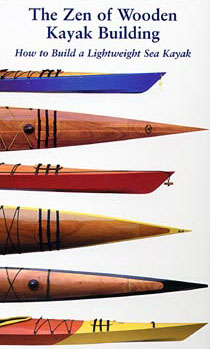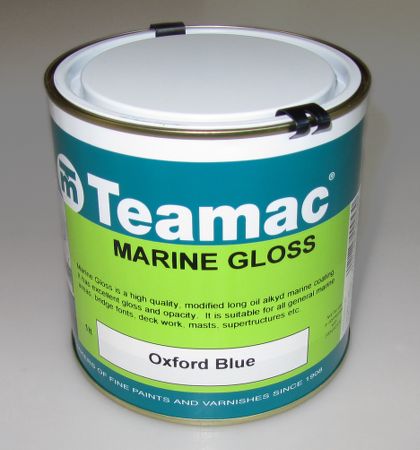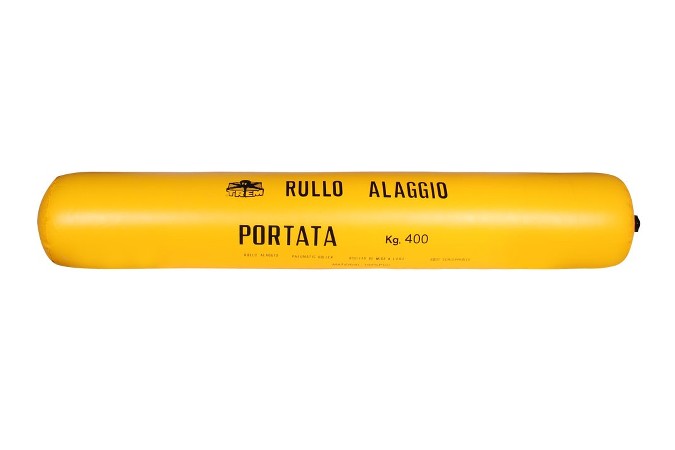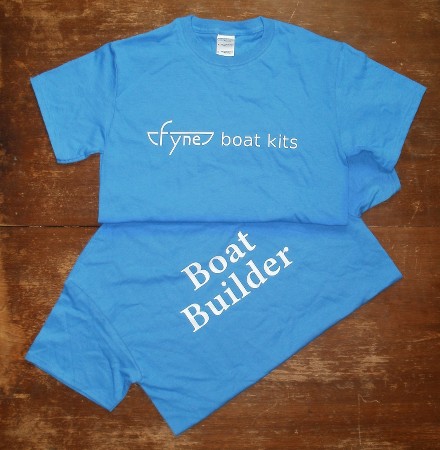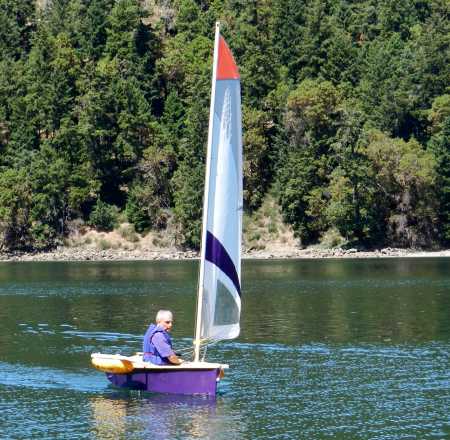

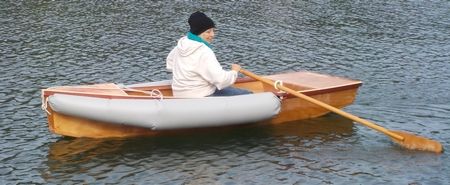
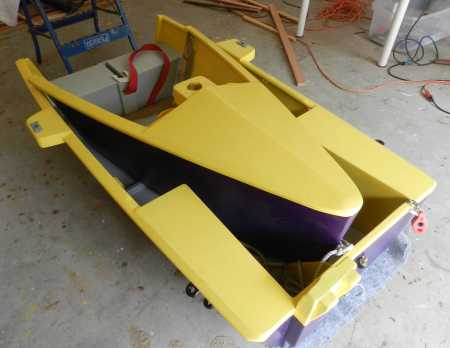
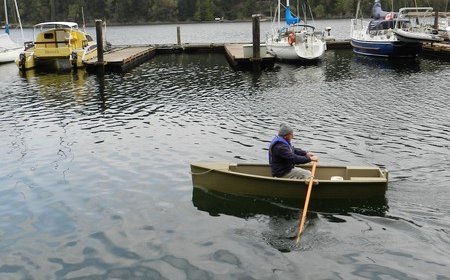
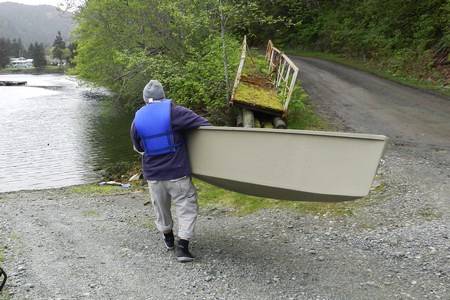






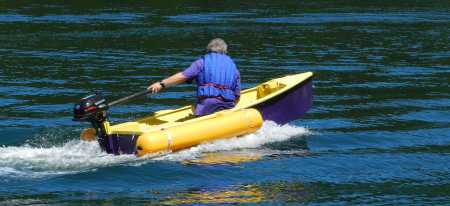
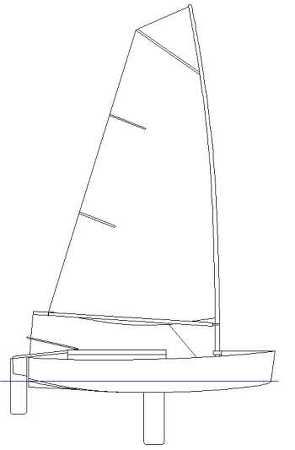
Product Description
The Duo is a simple to build rowing and sailing dinghy. It is also available as a nesting dinghy, so it is easy to store and can be transported in the back of a car.
Multihull designer Richard Woods designed the Duo as a tender to his main cruising boat, but also as a fun sailing dinghy that he would enjoy sailing when at anchor.
The Duo's narrow waterline makes the boat light and fast. Inflatable boat rollers are attached as collars when rowing or motoring, to keep the boat stable, dry and buoyant (similar to a RIB). They prevent scratching a yacht's hull when coming alongside and the added stability makes it easy for swimmers to re-board. They can even be removed and used as rollers if necessary.
To make a fast, fun and safe sailing boat, the collars are replaced by slot-in foam-filled wings (hull extensions), as used by many high performance dinghies. These wings make comfortable seats and add extra righting moment. The Duo also has an opening transom flap, common on racing boats, to avoid bailing after a capsize.
The Duo is also used as the main hull of the Tryst trimaran. The demountable Tryst outriggers can be retrofitted to an existing Duo after a few years use.
It is easy to lift on board and to carry up a beach. It is safe and seaworthy for two people (or three at a pinch) and has sufficient built-in buoyancy to support the crew if swamped.
The v-shaped transom reduces drag compared to a flat bottomed boat, especially at low speeds. But the v is not the whole length of the hull because that would add weight and extra building time.
Construction
The construction of the Duo is simplified to reduce build time. Even though the hull has a pronounced sheer to help keep the boat dry, the gunwales are actually the straight edges of the plywood sheet, so you only need to mark and cut a curve along the keel line.
All the panels for the rowing hull, as well as the daggerboard case and buoyancy compartments fore and aft, can be cut from two sheets of plywood. The sailing version needs another sheet to make the wings, rudder and daggerboard.
Despite being quick and cheap to build, the Duo is designed to be durable. 4 mm plywood is strong enough for this 10 foot boat; thicker plywood would just add unnecessary weight.
The build time, including the daggerboard case, outboard bracket, mast step and two coats of paint is about 35 hours.
Rowing
The pointed bow and extra length make the Duo fast and easy to row and it has a small skeg at the stern to help tracking. The Duo requires little effort to row with one person onboard.
Even without the collars attached, the Duo is safe and stable with buoyancy compartments in the bow, stern and thwart.
Sailing
Duo has a simple unstayed two-piece mast, which stows on the boat for transport without overhanging and also makes it possible to rig while in the water alongside the mothership. A mainsail set well forward keeps the cockpit large and uncluttered.
Even I am surprised how fast it is in light winds. It's also fun to sail, it's definitely not a ‘slop along placidly’ sort of dinghy.
Richard Woods, Duo designer
Motoring
As well as a high bow, the Duo has a high stern to take an outboard motor, or an electric motor. The outboard is offset (to port if right handed) making it easy to start and control.
Using a 2.5 HP outboard it can reach 7.5 knots with one person on board, but that is pushing the design as it was never intended to be a planing boat. It does 5 knots at less than half throttle. With two people on board it is capable of between 5.1 and 5.3 knots.
Nesting
The Duo can be built as a nesting version, with the join at the front edge of the thwart. When nested, it is 1.65 m (5′ 6″) long, 1 m (3′ 3″) wide and 500 mm (22″) high, which means the Duo can be stored onboard smaller boats and can fit inside a car, rather than on the roof.
It only takes a few minutes to join the two halves. The bottom is held by angle brackets that slot together, while the gunwales are held by two bolts; very simple and cheap.
If you have a big boat then the Duo fits easily in davits, without taking it apart.
- LOA: 3 m (10′)
- Beam: 1 m (3′ 3″)
- Beam, including wings: 1.5 m (5′)
- Hull weight: 20 kg (45 lb)
- Sail area: 5 m² (53 sq ft)
- Draught: 130/750 mm (5″/2′ 6″)
- Max. motor power: 2.5 HP
Plans and construction manual
The Duo dinghy plans include detailed specifications for building and rigging the boat. The quality and clarity of the plans ease the construction of this boat, though you still need to be confident of your plans-reading ability.
A complete materials list is supplied with the plans. All dimensions are in metric units.
PDF Plans
An electronic version of the plans in PDF format that can be viewed using Adobe Reader. After credit card authorisation the file will be sent to the email address put on the order form.


